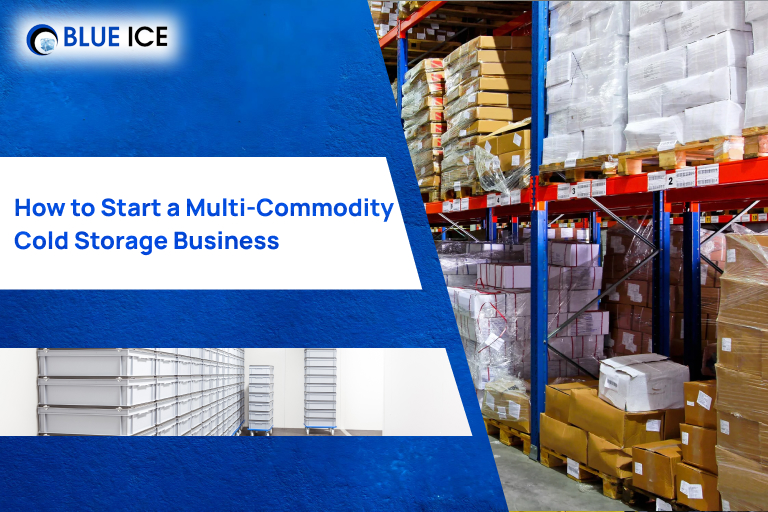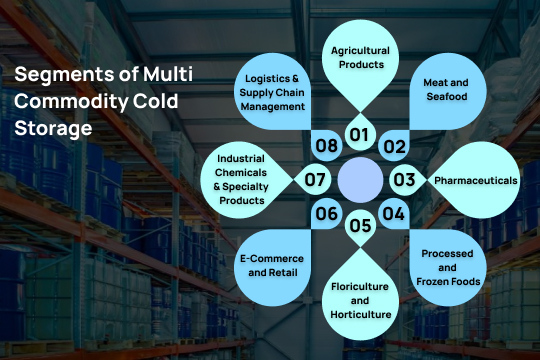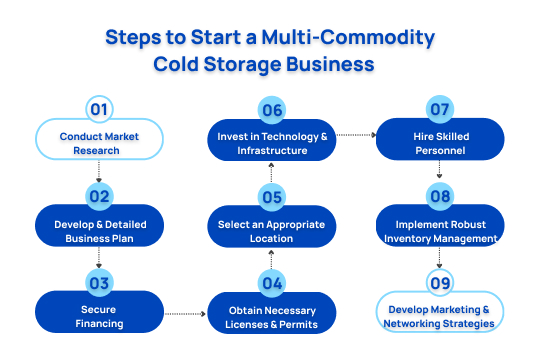
How to Start a Multi-Commodity Cold Storage Business
As fresh produce, pharmaceuticals, and other temperature-sensitive goods are in high demand, starting a multi-commodity cold storage venture may be profitable.
Get started with this multi-commodity cold storage guide to understand cold storage industry dynamics, how technology advances can help, and the challenges and opportunities the market has.
The Importance of Cold Storage in Modern Supply Chains
Cold storage rooms are required for perishable goods in many industries. They extend the shelf life for products including fresh produce, dairy, meats and pharmaceuticals by maintaining controlled temperature environments.
Such preservation is necessary to deliver to the consumer fresh and safe products (particularly critical in the food and healthcare industries).
Cold storage also helps stabilize market prices and provides a year-round supply of seasonal products. Businesses that store perishable commodities during peak production periods and release them when needed balance supply and demand dynamics.
This enables food security and business flexibility to meet consumer demand in an efficient and reliable supply chain.
Segments of Multi Commodity Cold Storage

-
1. Agricultural Products:
The agricultural industry uses cold storage to prevent post-harvest losses and ensure market access to fresh produce.
No matter whether it is vegetables and fruits like guavas and tomatoes or dairy products like butter and milk, multi-commodity cold storage stabilizes costs, keeps things fresh and also prevents spoilage.
-
2. Meat and Seafood:
The meat and seafood industries require precise refrigeration. Cold storage preserves the texture, taste, and safety of fresh meat and frozen seafood for transport and export, particularly when meeting strict international standards.
-
3. Pharmaceuticals:
In the pharmaceutical sector temperature control is critical for Vaccines, Medicines and Biological Samples. Cold storage facilities keep temperature-sensitive products intact, for healthcare and medical research worldwide.
-
4. Processed and Frozen Foods:
Cold storage is needed for ready-to-eat meals; bakery items; and frozen foods.
These facilities allow food manufacturers to maintain quality and meet consumer demand for convenience foods extending shelf life.
-
5. Floriculture and Horticulture:
Cold storage in floristry and horticulture industries extends the market life of cut flowers and ensures healthy growth of plant saplings. It improves product quality and avoids spoilage in the markets.
-
6. E-Commerce and Retail:
Cold storage is necessary for online grocery services and meal kit deliveries.
It ensures that perishable goods like fruits, vegetables and meats reach customers in optimum condition from warehouse to doorstep.
-
7. Industrial Chemicals and Specialty Products:
Some chemicals and cosmetics work best in temperature-controlled conditions. Cold storage prevents the degrading of delicate items like essential oils & industrial chemicals used in special applications.
-
8. Logistics & Supply Chain Management:
Cold storage facilities are important distribution points that allow storage and transport of temperature-sensitive products.
They also permit cross-docking operations for quick transfers between transport modes without compromising quality of the product.
Investment Cost Breakdown for Multi Commodity Cold Storage
| Investment Component | Details |
|---|---|
| Purchasing Cooling Machinery | Advanced refrigeration systems & equipment for correct storage conditions. |
| Land and Facility Construction | Buy/Rent Land & build cold storage with required infrastructure. |
| Licensing and Permits | Getting government licenses and approvals for legal operations from local authorities. |
| Utilities | Electricity, water and sundry monthly expenses needed for operations. |
| Staff Salaries | Hiring professionals for operations, management and maintenance. |
| Daily Expenditures | Day-to-day operational costs (the maintenance) the unforeseen expenses. |
| Marketing and Promotion | Advertising - branding (client acquisition) & promotional activities for market presence. |
Steps to Start a Multi-Commodity Cold Storage Business

-
1. Conduct Market Research
Start with local/regional demand for cold storage services. Find out what commodities are popular and how much competition exists.
Understanding how the market behaves will help shape services needed to fulfil a specific need and so, help business viability.
-
2. Develop a Detailed Business Plan
Detailed business plans should detail your business goals and target market, financial projections, and operation plans.
They should also outline the cold storage product types you'll offer, staffing needs, marketing, and a SWOT analysis of strengths, weaknesses, opportunities, and threats.
-
3. Secure Financing
A cold storage firm requires a significant capital investment. To reduce initial costs, look into financing through business loans from financial institutions such as SBI, HDFC Bank, and NABARD, which have schemes just for cold storage ventures.
Also, consider government subsidies and grants for agro-based industries.
-
4. Obtain Necessary Licenses and Permits
Comply with legal and regulatory requirements Obtain any required licenses and permits.
This could involve business enrollment, health and safety certificates, and environmental clearances in addition to neighbourhood zoning laws. Compliance prevents legal issues and helps with smooth operations.
-
5. Select an Appropriate Location
Select a location that suppliers and markets can easily reach. Proximity to agricultural hubs or main transport ways could decrease logistics costs and service time, respectively. Ensure that the site has adequate infrastructure including electricity and water supply for storage conditions.
-
6. Invest in Technology and Infrastructure
Give your facility modern refrigeration systems that can maintain temperature zones for different commodities. Install advanced monitoring systems for temperature and humidity real-time tracking.
Investments in energy-efficient technologies may result in lower operational costs and added environmental and/or social benefits.
-
7. Hire Skilled Personnel
Hire qualified staff who understand cold storage operations, such as facility managers, technicians, and quality control personnel. Provide recurrent training about best practices in storage management, equipment handling, and safety procedures.
-
8. Implement Robust Inventory Management
Employ effective inventory management systems to check stock levels, product condition, and storage space.
Digital solutions can make the operation more accurate, and goods can be retrieved and dispatched on time.
-
9. Develop Marketing and Networking Strategies
Make a powerful brand claim about what makes your cold storage company different: state-of-the-art facilities, strategic location, quality, etc.
Network with local farmers, distributors, and retailers to establish clientele. Use digital platforms in addition to social media to increase audience and market credibility.
Wrapping Up
Starting a multi-commodity cold storage business in India is an opportunity to contribute to the agricultural supply chain and meet growing perishable goods preservation demand.
If you follow the steps - market research, detailed business plan, financing and modern infrastructure - you can set up a sustainable enterprise.
At Blue Ice India, we provide complete cold storage solutions for new and existing multi-commodity cold storage businesses.
Our knowledge of designing and installing effective cold storage products guarantees that your facility meets industrial standards. Build a solid foundation for your cold storage venture with us.
Frequently Asked Questions
Benefits include extended shelf life of products, reduced spoilage, improved product quality, and the ability to store multiple products in one location, optimizing logistics and costs.
The facility uses advanced temperature and humidity control systems to create specific conditions required for different commodities, ensuring that products remain fresh and safe for consumption.
Products like fruits, vegetables, dairy products, frozen foods, seafood, meat, and pharmaceutical items can be stored in multi-commodity cold storage.

